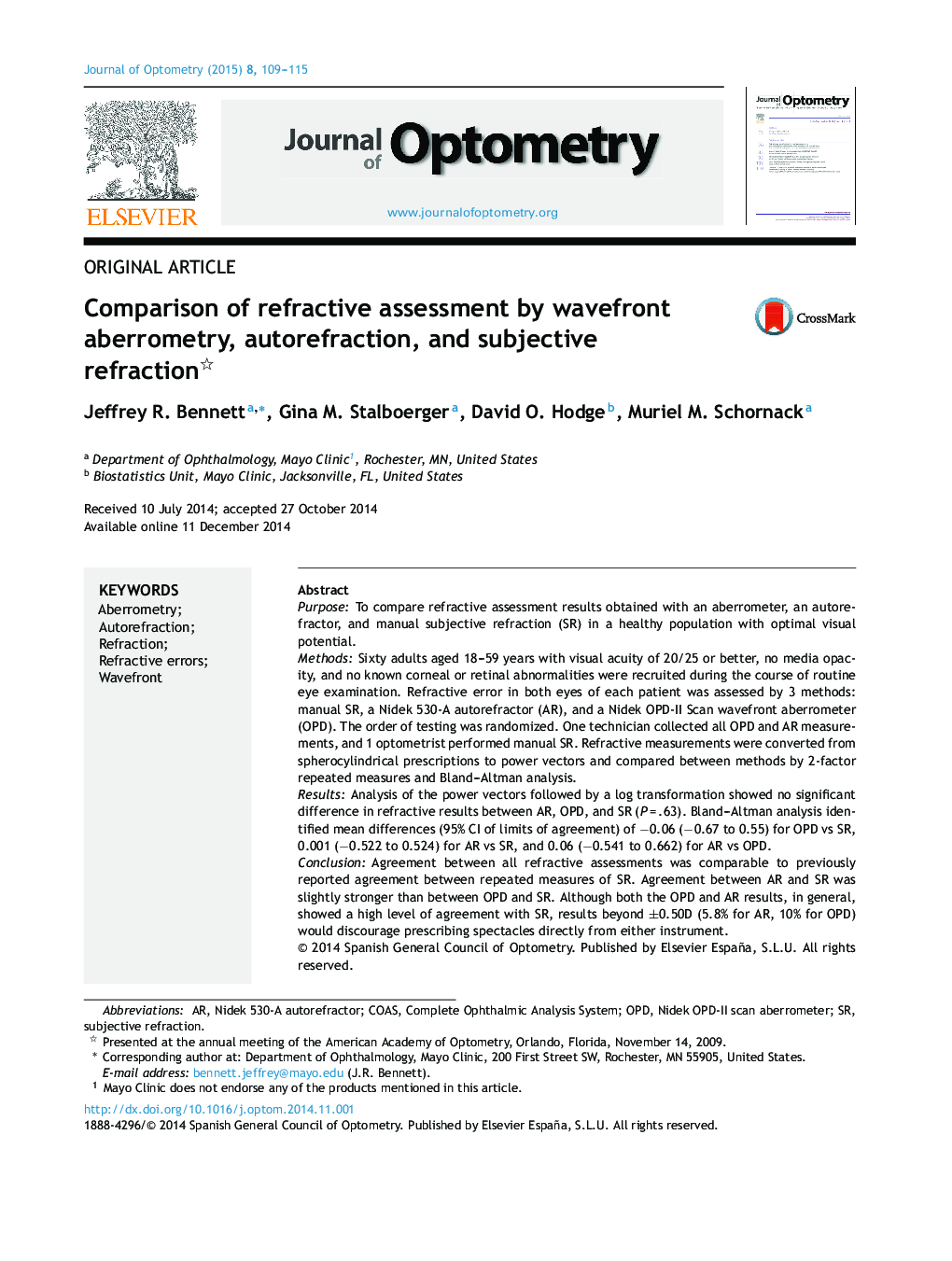| کد مقاله | کد نشریه | سال انتشار | مقاله انگلیسی | نسخه تمام متن |
|---|---|---|---|---|
| 2700742 | 1144366 | 2015 | 7 صفحه PDF | دانلود رایگان |
PurposeTo compare refractive assessment results obtained with an aberrometer, an autorefractor, and manual subjective refraction (SR) in a healthy population with optimal visual potential.MethodsSixty adults aged 18–59 years with visual acuity of 20/25 or better, no media opacity, and no known corneal or retinal abnormalities were recruited during the course of routine eye examination. Refractive error in both eyes of each patient was assessed by 3 methods: manual SR, a Nidek 530-A autorefractor (AR), and a Nidek OPD-II Scan wavefront aberrometer (OPD). The order of testing was randomized. One technician collected all OPD and AR measurements, and 1 optometrist performed manual SR. Refractive measurements were converted from spherocylindrical prescriptions to power vectors and compared between methods by 2-factor repeated measures and Bland–Altman analysis.ResultsAnalysis of the power vectors followed by a log transformation showed no significant difference in refractive results between AR, OPD, and SR (P = .63). Bland–Altman analysis identified mean differences (95% CI of limits of agreement) of −0.06 (−0.67 to 0.55) for OPD vs SR, 0.001 (−0.522 to 0.524) for AR vs SR, and 0.06 (−0.541 to 0.662) for AR vs OPD.ConclusionAgreement between all refractive assessments was comparable to previously reported agreement between repeated measures of SR. Agreement between AR and SR was slightly stronger than between OPD and SR. Although both the OPD and AR results, in general, showed a high level of agreement with SR, results beyond ±0.50D (5.8% for AR, 10% for OPD) would discourage prescribing spectacles directly from either instrument.
ResumenObjetivoComparar los resultados de la evaluación refractiva obtenidos mediante aberrómetro, autorefractómetro y refracción subjetiva manual (RS) en una población sana con un potencial visual óptimo.MétodosSe reclutó a sesenta adultos de edades comprendidas entre 18 y 59 años, con agudeza visual de 20/25 o superior, sin opacidad de medios, y sin anomalías retinianas o corneales, en el curso de un examen ocular rutinario. Se evaluó el error refractivo en los dos ojos de cada paciente mediante tres métodos: RS manual, un autorrefractómetro (AR) Nidek 530-A, y un aberrómetro por frente de onda Nidek OPD-II Scan (OPD). El orden de las pruebas fue aleatorio. Un técnico recolectó todas las mediciones de OPD y AR, y un optometrista llevó a cabo la RS manual. Las mediciones refractivas se transformaron de prescripciones esferocilíndricas en vectores de potencia, comparándose entre sí los tres métodos mediante mediciones repetidas de dos factores y análisis de Bland–Altman.ResultadosEl análisis de los vectores de potencia, seguido de una transformación logarítmica, no reflejó ninguna diferencia significativa de los resultados refractivos entre AR, OPD, y RS (P = 0,63). El análisis de Bland–Altman identificó diferencias medias (95% de IC de los límites de acuerdo) de–0,06 (–0,67-0,55) D para OPD frente a RS, 0,001 (–0,522-0.524) D para AR frente a RS, y 0,06 (–0,541-0,662) D para AR frente a OPD.ConclusiónLa concordancia entre todas las evaluaciones refractivas fue comparable a la concordancia previamente reportada entre las mediciones repetidas de RS. La concordancia entre AR y RS fue ligeramente superior que entre OPD y RS. Aunque en general los resultados de OPD y AR reflejaron un elevado nivel de concordancia con RS, los resultados que exceden la diferencia de ±0.50D (5.8% para AR, 10% para OPD) no permiten realizar la prescripción de gafas con cualquiera de ambos instrumentos.
Journal: Journal of Optometry - Volume 8, Issue 2, April–June 2015, Pages 109–115
